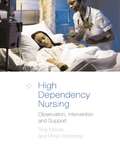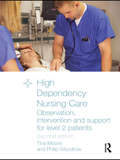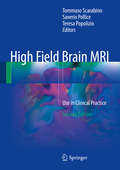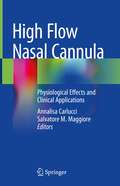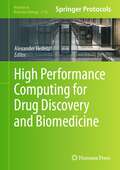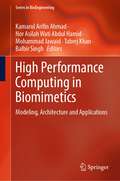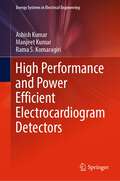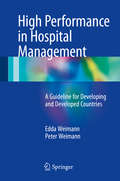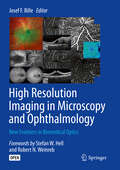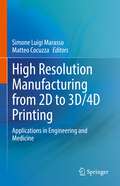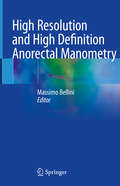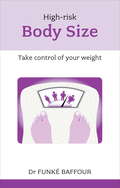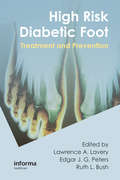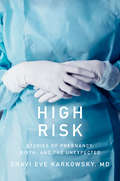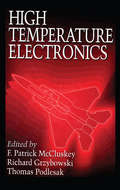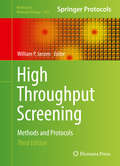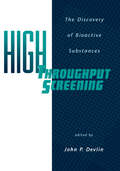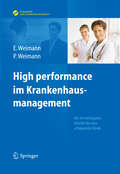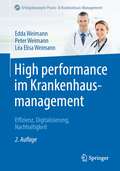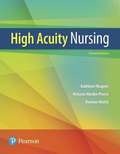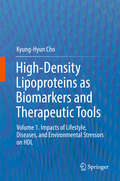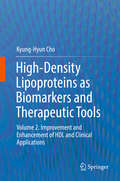- Table View
- List View
High Dependency Nursing Care: Observation, Intervention and Support for Level 2 Patients
by Philip Woodrow Tina MooreWritten by a team of nurses experienced in providing, supporting and developing high dependency care, this book discusses practical issues and explores the current evidence base for clinical practice. It covers all important skills needed and best practice for caring for high dependency patients or undertaking post registration courses to prepare them for high dependency nursing. Structured in four parts, the first, ‘Perspectives on High Dependency Care’ explores the contest of care, focusing on fundamental aspects like sleep, nutrition, pain management and stress, demonstrating how to achieve quality nursing care. ‘Pathophysiology and Treatments’ describes the main diseases that cause critical illness and treatments that patients will often be given. ‘Monitoring and Skills’ enables nurses to interpret and understand the information gained from observation and monitoring. The final part, ‘Professional Issues’ explores topics like clinical governance, reflection, practice development and managing change to assist nurses in developing their own clinical practice and professional development.
High Dependency Nursing Care: Observation, Intervention and Support for Level 2 Patients
by Philip Woodrow Tina MooreLevel 2 (highly dependent) patients are nursed in a variety of clinical areas. High Dependency Nursing Care has been written for pre qualified and post qualified students undertaking modules and placements to prepare them for nursing the acutely ill and nurses caring for these patients. Written by a team of nurses experienced in providing, supporting and developing high dependency care, it discusses practical issues and explores the current evidence base for clinical practice. This essential textbook covers the context of care with chapters on fundamental aspects, such as sleep, nutrition, pain management and stress. It goes on to look at the main causes of critical illness and the treatments often given, as well as the skills necessary for monitoring patients. Completely updated throughout, this second edition also includes new chapters on infection control, heart failure, tissue removal and transferring the sicker patient. High Dependency Nursing Care is: Comprehensive: it covers all the key areas of knowledge needed User-friendly: it includes learning outcomes, introductions, time out exercises, implications for practice, useful websites and up-to-date references Clearly written: by a team of experienced nurses Practically based: clinical scenarios provide stimulating discussion and revision topics
High Field Brain MRI
by Tommaso Scarabino Saverio Pollice Teresa PopolizioThis book describes the development of systems of magnetic resonance imaging using the higher magnetic field strength of 3 tesla, in comparison to the current gold standard of 1. 5 tesla. These new systems of MRI make it possible to perform with high spatial, temporal and contrast resolution not only morphological examinations but also functional studies on spectroscopy, diffusion, perfusion, and cortical activation, thus helping research and providing an important tool for routine diagnostic activity. At the same time the new systems offer unparalleled sensitivity and specificity in the numerous conditions of neuroradiological interest.
High Flow Nasal Cannula: Physiological Effects and Clinical Applications
by Annalisa Carlucci Salvatore M. MaggioreThis book presents the state of the art in high-flow nasal cannula (HFNC), an oxygen therapy technique that has recently proven to be a very promising approach to supporting respiratory function in several medical fields.In the opening part of the book, readers will learn the differences between high-flow and low-flow techniques and gain an overview of HFNC’s technical aspects and physiological effects. The book subsequently describes the pathophysiological mechanisms involved in different respiratory diseases, analyzing how this technique positively impacts patients’ respiratory status. The authors highlight clinical applications of HFNC, both in adults and in children, in various clinical settings – e.g. intensive care and semi-intensive care unit, emergencies, rehabilitation etc. – and present tips, tricks and pitfalls, as well as up-to-date reports on technical issues. The book is intended for pneumologists, intensivists, anesthesiologists, ED doctors, rehabilitation therapists, internists and oncologists, as well as fellows and nurses in these fields.
High G Flight: Physiological Effects and Countermeasures
by David NewmanThis book provides a unique, authoritative and detailed examination of the physiological and clinical consequences of human exposure to high G forces. Pilots of military fast jets, civilian aerobatic pilots and astronauts during the launch and re-entry phases of spaceflight are frequently and repetitively exposed to high G forces, for which the human body is not fundamentally designed. The book examines not only the nature of the high G environment, but the physiological effects of exposure to high G on the various systems of the human body. In particular, the susceptibility of the human cardiovascular system to high G is considered in detail, since G-Induced Loss of Consciousness (G-LOC) is a serious hazard for high G pilots. Additionally, the factors that influence tolerance to G and the emerging scientific evidence of physiological adaptation to high G are examined, as are the various countermeasures and techniques that have been developed over the years to protect pilots from the potentially adverse consequences of high G flight, such as the G-suit and positive pressure breathing. The accumulated knowledge of human exposure to high G is drawn together within High G Flight, resulting in a definitive volume on the physiological effects of high G and their countermeasures.
High Performance Computing for Drug Discovery and Biomedicine (Methods in Molecular Biology #2716)
by Alexander HeifetzThis volume explores the application of high-performance computing (HPC) technologies to computational drug discovery (CDD) and biomedicine. The first section collects CDD approaches that, together with HPC, can revolutionize and automate drug discovery process, such as knowledge graphs, natural language processing (NLP), Bayesian optimization, automated virtual screening platforms, alchemical free energy workflows, fragment-molecular orbitals (FMO), HPC-adapted molecular dynamic simulation (MD-HPC), and the potential of cloud computing for drug discovery. The second section delves into computational algorithms and workflows for biomedicine, featuring an HPC framework to assess drug-induced arrhythmic risk, digital patient applications relevant to the clinic, virtual human simulations, cellular and whole-body blood flow modeling for stroke treatments, prediction of the femoral bone strength from CT data, and many more subjects. Written for the highly successful Methods in Molecular Biology series, chapters include introductions to their respective topics, lists of the necessary software and tools, step-by-step and readily reproducible modeling protocols, and tips on troubleshooting and avoiding known pitfalls. Authoritative and practical, High Performance Computing for Drug Discovery and Biomedicine allows a diverse audience, including computer scientists, computational and medicinal chemists, biologists, clinicians, pharmacologists and drug designers, to navigate the complex landscape of what is currently possible and to understand the challenges and future directions of HPC-based technologies.
High Performance Computing in Biomimetics: Modeling, Architecture and Applications (Series in BioEngineering)
by Mohammad Jawaid Tabrej Khan Kamarul Arifin Ahmad Balbir Singh Nor Asilah Wati Abdul HamidThis book gives a complete overview of current developments in the implementation of high performance computing (HPC) in various biomimetic technologies. The book presents various topics that are subdivided into the following parts: A) biomimetic models and mechanics; B) locomotion and computational methods; C) distributed computing and its evolution; D) distributed and parallel computing architecture; E) high performance computing and biomimetics; F) big data, management, and visualization; and G) future of high performance computing in biomimetics. This book presents diverse computational technologies to model and replicate biologically inspired design for the purpose of solving complex human problems. The content of this book is presented in a simple and lucid style which can also be used by professionals, non-professionals, scientists, and students who are interested in the research area of high performance computing applications in the development of biomimetics technologies.
High Performance and Power Efficient Electrocardiogram Detectors (Energy Systems in Electrical Engineering)
by Ashish Kumar Manjeet Kumar Rama S. KomaragiriThis book details the characteristics of an ECG signal through the functionality and electrical activity of the human heart. This book provides a basic introduction and needs for developing implantable cardiac pacemaker systems. This book provides comprehensive details on ECG signal processing techniques that are useful for fast and accurate diagnosis of cardiovascular diseases. The book discusses the characteristics and parameters of a typical ECG signal and various noises that can corrupt an ECG signal. It also covers various challenges involved in different stages of signal acquisition, preprocessing, and detection of an ECG signal. The book also presents a detailed survey of various ECG signal detection and data compression techniques. The book contains detailed information on ECG signals and various noises that corrupt an ECG signal. It also includes de-noising techniques, ECG peak detection techniques, and ECG data compression techniques. It also includes step-by-step details to design various filters in MATLAB. This book, through detailed explanations, provides the reader with necessary information on ECG signal, ECG signal acquisition process, noise removal techniques, and the detection of ECG peaks.
High Performance in Hospital Management
by Edda Weimann Peter WeimannThisbook provides a broad overview of what is needed to run hospitals and otherhealth care facilities effectively and efficiently. All of the skills and toolsrequired to achieve this aim are elucidated in the book, including businessengineering and change management, strategic planning and the Balanced Scorecard,project management, integrative innovation management, social and ethical aspectsof human resource management, communication and conflict management, staffdevelopment and leadership. The guidance offered is exceptional and applicable inboth developed and developing countries. Furthermore, the relevant theoretical backgroundis outlined and instructive case reports are included. Each chapter finishes witha summary and five reflective questions. Excellence can only be achieved when healthcare professionals show in addition to their medical skills a high level ofmanagerial competence. High performance in Hospital Management assists managersof health care providers as well as doctors and nurses to engage in thesuccessful management of a health care facility.
High Resolution Imaging in Microscopy and Ophthalmology: New Frontiers in Biomedical Optics
by Josef F. BilleThis open access book provides a comprehensive overview of the application of the newest laser and microscope/ophthalmoscope technology in the field of high resolution imaging in microscopy and ophthalmology. Starting by describing High-Resolution 3D Light Microscopy with STED and RESOLFT, the book goes on to cover retinal and anterior segment imaging and image-guided treatment and also discusses the development of adaptive optics in vision science and ophthalmology. Using an interdisciplinary approach, the reader will learn about the latest developments and most up to date technology in the field and how these translate to a medical setting. High Resolution Imaging in Microscopy and Ophthalmology – New Frontiers in Biomedical Optics has been written by leading experts in the field and offers insights on engineering, biology, and medicine, thus being a valuable addition for scientists, engineers, and clinicians with technical and medical interest who would like to understand the equipment, the applications and the medical/biological background. Lastly, this book is dedicated to the memory of Dr. Gerhard Zinser, co-founder of Heidelberg Engineering GmbH, a scientist, a husband, a brother, a colleague, and a friend.
High Resolution Manufacturing from 2D to 3D/4D Printing: Applications in Engineering and Medicine
by Simone Luigi Marasso Matteo CocuzzaThis book provides a comprehensive presentation of the most frequently used high resolution manufacturing techniques available, as well as the polymeric materials used for each of the techniques. Divided into two parts covering the technologies and materials used and the impact on different research fields and case studies, High Resolution Manufacturing from 2D to 3D/4D Printing: Applications in Engineering and Medicine addresses issues like throughput improvement by volumetric 3D printing and presenting novel applications and case studies. In addition, this book also covers the latest breakthrough developments and innovations to help readers understand the future applications of this technology across various disciplines, including biomedicine, electronics, energy, and photonics.
High Resolution and High Definition Anorectal Manometry
by Massimo BelliniThe book provides a comprehensive overview of high resolution and high definition anorectal manometry (HRAM/HDAM), showing the possible benefits of a wider use of these techniques in clinical practice, as well as their limitations. Although these techniques provide fresh insights into anorectal function and offer a new perspective on the pathophysiologic mechanisms of many defecation disturbances, there is a need to clarify whether their use has beneficial effects on clinical management compared to conventional manometry. There is still a considerable way to go to gain the clinical diffusion of esophageal HRM, which has become the gold standard in studying esophageal motility. Indeed, many gastroenterologists and surgeons are convinced that further studies are necessary in order to be able to recommend HRAM and HDAM over and above conventional anorectal manometry. The first part of the book presents anorectal anatomy and pathophysiology, highlighting the indications and limitations of conventional anorectal manometry. The second part then focuses on the general concepts of high resolution manometry and the difference between conventional anorectal manometry and HRAM/HDAM, including technical aspects and different equipment. The third part explains how to perform, analyze and interpret HRAM and HDAM recordings, and describes the parameters study protocol, normal values and how to formulate a particular diagnosis. Lastly, the fourth part includes a collection of normal and pathological images with a glossary of the most frequently terms. Written by experts in the field of anorectal manometry and defecation disorders, this book is of interest to specialists and residents dealing with these conditions.
High Risk Body Size: Take Control Of Your Weight
by Funke BaffourMany people feel they've tried everything in a vain attempt to lose weight - but make the mistake of looking at eating plans, instead of the thinking that drives their behaviour. High Risk Body Size says that diets fail in the mind, not the body, and takes an exciting, challenging look at the underlying psychological reasons for excess and unwanted weight gain. It shows how to break out of the obsession with weight, and the need for instant remedies, which may in themselves become dangers to our health, and looks at why some people opt for weight loss surgery as a desperate last remedy despite its well-publicised risks. Overweight people are often misunderstood as being weak-willed, but they may simply need to learn new ways of thinking - this book shows you how.
High Risk Body Size: Take Control Of Your Weight
by Funke BaffourMany people feel they've tried everything in a vain attempt to lose weight - but make the mistake of looking at eating plans, instead of the thinking that drives their behaviour. High Risk Body Size says that diets fail in the mind, not the body, and takes an exciting, challenging look at the underlying psychological reasons for excess and unwanted weight gain. It shows how to break out of the obsession with weight, and the need for instant remedies, which may in themselves become dangers to our health, and looks at why some people opt for weight loss surgery as a desperate last remedy despite its well-publicised risks. Overweight people are often misunderstood as being weak-willed, but they may simply need to learn new ways of thinking - this book shows you how.
High Risk Diabetic Foot: Treatment and Prevention
by Lawrence A. Lavery Ruth L. Bush Edgar J. G. PetersEmphasizing a team approach that includes the practicing podiatrist, endocrinologist, diabetologist, vascular surgeon, orthopedist, and infectious disease specialist, The High Risk Diabetic Foot provides a thorough and detailed resource on the management of complex diabetic foot problems. This comprehensive text is an essential tool that will enabl
High Risk: A Doctor's Notes On Pregnancy, Birth, And The Unexpected
by Chavi Eve Karkowsky MDA doctor’s revelatory account of pregnancy and the complexity of reproductive life—and everything we lose when we don’t speak honestly about women’s health. “My work offers a window into the darkest and lightest corners of people’s lives, into the extremes of human experience,” writes Dr. Chavi Eve Karkowsky in High Risk, her timely and unflinching account of working in maternal-fetal medicine—that branch of medicine that concerns high-risk pregnancies. Whether offering insight into the rise in home births, the alarming rise in America’s maternal mortality rate, or the history of involuntary sterilization, Karkowsky offers a window into all that pregnancy, labor, and birth can entail—birth and joy, but also challenge and loss—illustrating the complexity of reproductive life and the systems that surround it. With historical insight and journalistic verve, Karkowsky unpacks what is involved for women, for a family, and for us as a society; and explores what’s at risk when these aspects of medicine remain clouded in mystery and misinformation.
High Society
by Daniel KallaFrom internationally bestselling author Daniel Kalla comes a twisty psychological thriller about a pioneering psychiatrist hiding dark secrets, in the vein of The Golden Couple by Hendricks and Pekkanen and Nine Perfect Strangers by Liane Moriarty.At sixteen, Holly Danvers barely survived the car accident that killed her father. While she has no memory of the crash, it took an ayahuasca treatment, a native plant-based psychedelic therapy, in the jungles of Peru for her to emotionally recover. Twenty years later, Holly is a sought-after psychiatrist determined to use her expertise with psychedelics to treat patients suffering from addictions. Ignoring the risks, she embarks upon an unproven new protocol with miraculous results. But her success in probing the traumas of her patients and the secrets they keep is short-lived. When one celebrity client goes public with his recovery and another overdoses after accusing Holly of improprieties, her world is turned upside down. With her career on the line, Holly reaches out to her mentor—and estranged husband—Dr. Aaron Laing, for advice and comfort. But he has a different agenda, and it soon becomes clear that it will be up to Holly alone to figure out why her clients are relapsing and dying. To accomplish that, she will have to risk her life and revisit her own deep-seated trauma.
High Temperature Electronics
by F. Patrick McCluskey Thomas Podlesak Richard GrzybowskiThe development of electronics that can operate at high temperatures has been identified as a critical technology for the next century. Increasingly, engineers will be called upon to design avionics, automotive, and geophysical electronic systems requiring components and packaging reliable to 200 °C and beyond. Until now, however, they have had no single resource on high temperature electronics to assist them.Such a resource is critically needed, since the design and manufacture of electronic components have now made it possible to design electronic systems that will operate reliably above the traditional temperature limit of 125 °C. However, successful system development efforts hinge on a firm understanding of the fundamentals of semiconductor physics and device processing, materials selection, package design, and thermal management, together with a knowledge of the intended application environments.High Temperature Electronics brings together this essential information and presents it for the first time in a unified way. Packaging and device engineers and technologists will find this book required reading for its coverage of the techniques and tradeoffs involved in materials selection, design, and thermal management and for its presentation of best design practices using actual fielded systems as examples. In addition, professors and students will find this book suitable for graduate-level courses because of its detailed level of explanation and its coverage of fundamental scientific concepts.Experts from the field of high temperature electronics have contributed to nine chapters covering topics ranging from semiconductor device selection to testing and final assembly.
High Throughput Screening
by William P. JanzenIn High Throughput Screening, leading scientists and researchers expert in molecular discovery explain the diverse technologies and key techniques used in HTS and demonstrate how they can be applied generically. Writing to create precisely the introductory guidebook they wish had been available when they started in HTS, these expert seasoned authors illuminate the HTS process with richly detailed tutorials on the biological techniques involved, the management of compound libraries, and the automation and engineering approaches needed. Extensive discussions provide readers with all those key elements of pharmacology, molecular biology, enzymology, and biochemistry that will ensure the identification of suitable targets and screens, and detail the technology necessary to mine millions of data points for meaningful knowledge.
High Throughput Screening: The Discovery of Bioactive Substances
by John P. DevlinFurnishing the latest interdisciplinary information on the most important and frequently the only investigational system available for discovery programs that address the effects of small molecules on newly discovered enzyme and receptor targets emanating from molecular biology, this timely resource facilitates the transition from classical to high
High performance im Krankenhausmanagement
by Edda Weimann Peter WeimannDer Band führt Einsteiger umfassend in das Management-Know-how für das Krankenhaus ein: Analyse, Strategie und Umsetzung. Managementwerkzeuge werden detailliert dargestellt und ihre erfolgreiche Anwendung als Teil eines Gesamtkonzeptes aufgezeigt. Die Autoren präsentieren Beispiele aus dem Klinikalltag und stellen innovative Konzepte für das Changemanagement vor. Praxiserprobte Lösungsvorschläge und Tipps aus der Praxis helfen bei der Umsetzung.
High performance im Krankenhausmanagement: Effizienz, Digitalisierung, Nachhaltigkeit (Erfolgskonzepte Praxis- & Krankenhaus-Management)
by Edda Weimann Peter Weimann Léa Elisa WeimannAnalyse – Strategie - UmsetzungMit Management Know-how erleichtern Sie Ihren Arbeitsalltag und steigern die Effizienz Ihres Teams.Welche Managementwerkzeuge gibt es? Hard skills: Balanced Score Card, Porters Wertschöpfungskette, Ishikawa-Diagramm, SWOT Analyse, Stakeholder Analyse, Lean ManagementSoft skills: Teambildung, Konfliktmanagement, Kommunikationskultur, Leadership, Mitarbeitermotivation, Transformation, System thinking Wie wende ich die einzelnen Managementwerkzeuge innerhalb eines Gesamtkonzeptes erfolgreich an? Praxisrelevante Lösungswege mit Tipps & TricksBeispiele aus dem Arbeitsalltag Krankenhäuser und SpitälerKonzepte für Ihr Change Management, zur Digitalisierung sowie dem klimarelevanten ökologischen und ökonomischen Wandel im GesundheitssystemWie erreichen wir klimaneutrale Kliniken und Praxen Methoden und Wissen, damit Sie mit passgenauen Argumenten und Verhandlungsstrategien Ihre Ziele erreichen. Dieses Buch bietet Ihnen das Management-Wissen, um mit intelligenten, innovativen sowie wie umwelt- und klimasensitiven Lösungen einen Spitzenplatz unter Ihren Mitbewerbern einzunehmen - nutzen Sie es. Agieren statt reagieren!
High-Acuity Nursing
by Karen Johnson Kathleen Wagner Melanie Hardin-Pierce Darlene WelshHigh-Acuity Nursing provides a comprehensive knowledge set needed to care for adult patients with complex, unpredictable conditions across settings, from high-skill, long-term facilities to critical care units. Focusing on the relationship between pathophysiology and the nursing process, the text encourages students to think critically to reach optimal clinical decisions for high-acuity patients. All chapters in the 7th edition have been updated and many have been reorganized and expanded. A new chapter focuses on palliative care and end-of-life issues, and new features address quality and safety, along with genetic considerations.
High-Density Lipoproteins as Biomarkers and Therapeutic Tools: Volume 1. Impacts of Lifestyle, Diseases, and Environmental Stressors on HDL
by Kyung-Hyun ChoThis book is the first of two volumes that offer a comprehensive, up-to-date account of current knowledge regarding high-density lipoprotein (HDL), the changes that occur in HDL under different conditions, the clinical applications of HDL, and means of enhancing HDL functionality. HDL comprises a diverse group of lipoproteins and its composition and metabolism are dynamic. In this volume, the focus is on the changes observed in HDL under different health statuses, with particular attention to the functional and structural correlations of HDL and apolipoprotein A-1. The impacts of a wide variety of factors on HDL are examined in depth, covering, for example, diet, exercise, smoking, age, diverse diseases, and different forms of environmental pollution. It has long been known that HDL has anti-atherosclerotic and antidiabetic properties, and more recently its anti-aging activities have been recognized. These benefits of HDL are highly dependent on its lipids, proteins, apolipoproteins, and enzymes, and specifically their composition and ratios. In documenting the latest knowledge in this field, this volume will be of interest to both researchers and clinicians.
High-Density Lipoproteins as Biomarkers and Therapeutic Tools: Volume 2. Improvement and Enhancement of HDL and Clinical Applications
by Kyung-Hyun ChoThis book is the second of two volumes that offer a comprehensive, up-to-date account of current knowledge regarding high-density lipoprotein (HDL), the changes that occur in HDL under different conditions, the clinical applications of HDL, and means of enhancing HDL functionality. In this volume, the focus is on the improvement of HDL, enhancement of its functionality, and the use of HDL for therapeutic purposes. In the first section, up-to-date information is provided on such topics as the tumor regression-promoting and antidiabetic activities of reconstituted HDL containing V156K apolipoprotein A-I, the enhancement of HDL effects by high doses of vitamin C, the benefits derived from incorporation of growth hormones 1 and 2 into rHDL, and the biological functions of omega-3 linolenic acid in rHDL. The enhancement of HDL functionality by policosanol and the resultant benefits are thoroughly examined in a separate section. Readers will also find the latest information on clinical applications of HDL. Here, specific topics include the enhancement of adenoviral gene delivery and the delivery of rapamycin. In documenting the latest knowledge in this field, this volume will be of interest to both researchers and clinicians.
